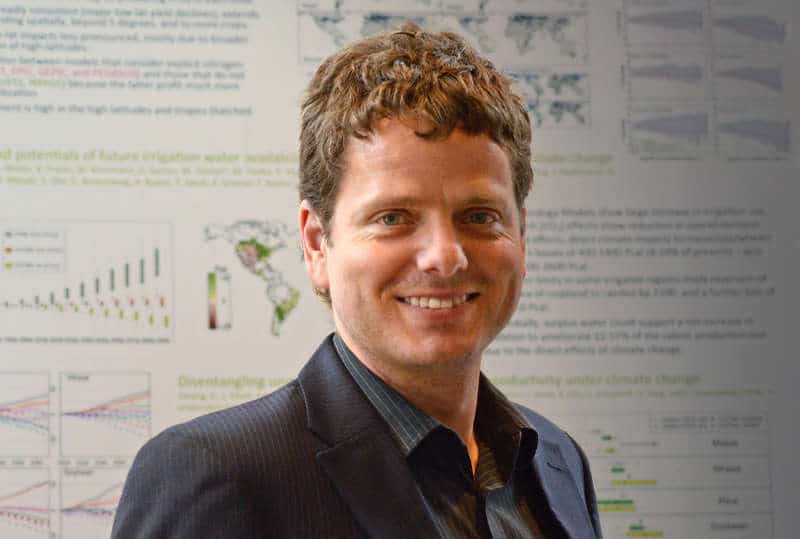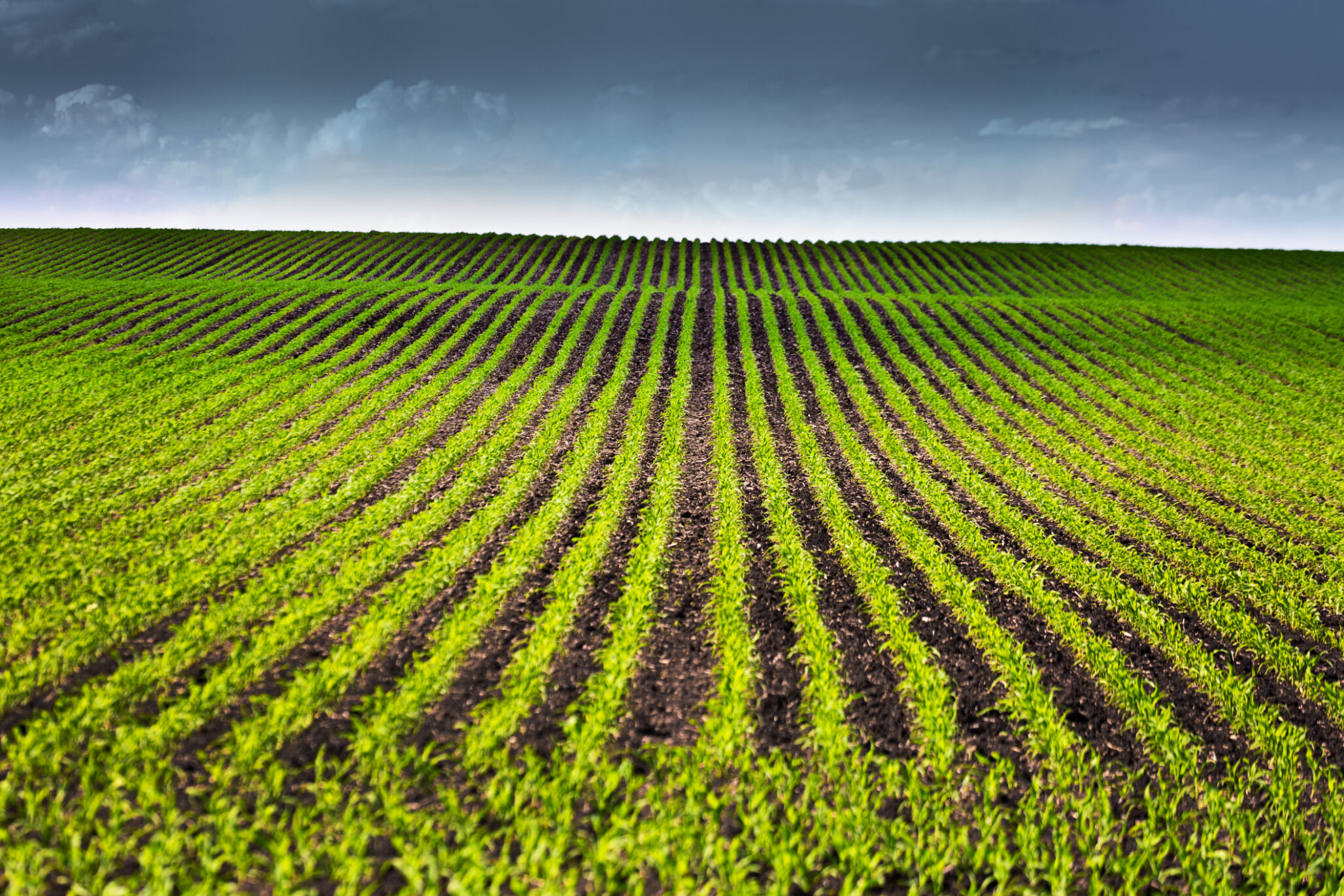As climate change alters the face of agriculture, one researcher is working to help the industry plan for possible future scenarios.
Joshua Elliott envisions a possible future in which cotton can no longer be profitably grown in much of the American South. Instead, the crop may be produced in the Midwest, and the great American Corn Belt may move north.
It’s just one potential scenario that Elliott, a University of Chicago climate change researcher who specializes in crafting computer models of what climate change could mean for agriculture, thinks might be a reality within the coming decades.
“Research on the impact risks from climate change has really evolved. We’re no longer just looking at single-incident risk factors in an isolated way, but integrating those pictures and thinking about future changes in technology, management and climate change, and how those will interact with other factors in complicated ways,” he says.
Elliott is conducting such research in order to better help stakeholders such as the agriculture industry not only adapt to the effects of climate change, but help to mitigate warming.
As efforts to breed drought tolerant plants ramp up, there’s also a desire — and a need — on the part of agriculture to actually get to the root of the climate change problem, rather than simply getting used to it.
One way to begin to do that is to envision what agriculture might look like in the future as a result of climate change, technology and even demand. Elliott works on predictions of agricultural production at seasonal time scales, the effects of large-scale extreme events (such as droughts and heat waves), and also socio-economic modeling and scenario analysis in the context of integrated climate assessment models.
The results have proven to be fascinating, if not daunting for the ag industry. Take this one, for instance: Elliott’s models predict the South will get hotter and drier, to the point where crops like cotton and corn can no longer be grown there.
“In North America, it’s probably true that growing regions will simply shift further north. A lot of the southeastern U.S. will suffer quite badly. The places where you currently grow most of your cotton, like the Mississippi Valley, will suffer,” he says. “Southern Iowa, Missouri and Illinois could become the new cotton belt, and the Corn Belt could move much further north over the next 50 years.”
That means big changes, and a lot of expense, for the American ag industry. It’s why companies like Monsanto — itself in the process of merging with Bayer — are taking notice of Elliott’s research.
“We’ve talked in the past a lot about adaptation to climate change and how things are going to be hotter and drier in many parts of the globe, but not necessarily everywhere. Other regions will get more moisture and will see their growing seasons lengthen,” says Mike Lohuis, ag environmental strategy lead for Monsanto.
“It’s not enough just to adapt to climate change. When we began looking at the implications of that, we did some internal calculations and narrowed it down to a handful of strategies that had the best potential to actually mitigate climate change.”
The result is Monsanto’s recent report Charting a Path to Carbon Neutral Agriculture, which is part of the company’s plan to make its operations carbon neutral by 2021 through a unique program targeted across its seed and crop protection operations, as well as through collaboration with farmers.
The company’s efforts focus on several key areas, among them seed production, crop protection, sharing data and increasing adoption of best practices in an effort to mitigate the effects of climate change.
In the fight against climate change, it’s the company’s way of ensuring its success as areas of the globe see unprecedented climatic conditions.
“Working with Joshua to understand what will happen to our major row crops with climate change has been a real eye-opener. He took all the different general circulation climate models that will predict what climate outcomes we’re likely to see and presented them to us in a way that clearly illustrates what the agricultural landscape could soon look like,” Lohuis says.
“There are so many questions. Will the Canadian Prairies get more rain or not? The rain they do get will likely be in larger amounts, but maybe not as frequent. The American South, it looks like it may get tough to grow crops there. It really helps us as a company to see it laid out so we can plan for not just our future, but for the industry’s. This is bigger than just our company. How can the ag sector bring to bear the mitigation schemes that could actually work and wouldn’t cost an enormous amount of money?”

Mitigation Schemes
Those schemes fall into four main strategies: sustainable nutrient management (through the use of precision ag and soil nitrification inhibitors), sustainable tillage and use of cover crops (thereby keeping carbon sequestered in the soil), ethanol production from corn (excess corn grain and stover not needed for food and feed can be used for biofuel production), and optimization of the use of available crop residues (for example, corn stover could be used to produce carbon-rich soil amendments like biochar or co-fired alongside coal in coal-fired power plants to offset fossil fuel use).
The first two strategies are near-term strategies, and are already in use and seeing success but need to be expanded, notes Lohuis.
“How do you reduce direct ag emissions today from the use of fertilizer, manure and fuel? How do you optimize all the inputs that go onto the land? We think the answer there is precision agriculture,” he says.
“When you start to understand the different soil types, weather patterns and crop rotations, we can use all those data layers to feed a script back to farmers through their equipment to deliver that script in a very precise manner. You can apply just enough nitrogen at just the right time to meet the plant’s needs, rather than applying too much or at the wrong time or place and a risk it being eventually leached away.”
If 60 percent of the cropland not currently using the near-term strategies begins to adopt the near-term practices by 2030, over 100 million metric tons of CO2 emissions reductions could be achieved from U.S. agriculture alone. More than 90 percent of that potential could be accomplished from adopting these practices for corn and soybean crops.
The long-term strategies each have similar mitigation potentials, but it will take time to fully realize because technological and economic barriers currently exist for the adoption of these strategies. More research is needed in these areas, the study notes.
The largest agricultural source of emission comes from an indirect source,” Lohuis says.
“When ag expands its footprint, chopping down trees or draining wetlands, it leads to fairly significant amounts of emissions. How can we freeze the footprint of ag, slow down this expansion and turn it around and start to spare land for other purposes?”
That is perhaps the biggest question. According to Elliott, even as crops begin to move further north to be grown, they will hit a natural wall. Land that was frozen tundra for thousands of years did not develop the quality soil needed to grow crops, he notes. But the question is how many new emissions will be generated as farming ramps up in regions that before didn’t see such intensive agriculture?
And that’s where the real cost comes in.
“This northward shift, that costs money. It means moving the infrastructure from the U.S. Corn Belt further north. It won’t be free, but obviously we have highly developed industrialized agriculture, and that shift will happen as time goes on,” Elliott says.
“There are parts of the world where that’s not true, like Africa and South Asia, where they generally don’t have the adaptation options and/or they don’t have the wealth and resources to take advantage of those options. The dynamics in the U.S. will be much different.”











